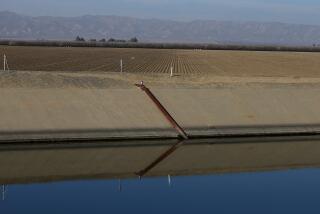Babbitt Unveils Everglades Rescue Plan : Environment: Tentative accord among the state, U.S. governments and big sugar growers is hailed as realistic compromise. Others call it a betrayal.
- Share via
WASHINGTON — Seeking to end a five-year impasse, Interior Secretary Bruce Babbitt announced a preliminary agreement Tuesday to restore parts of the environmentally troubled Florida Everglades under a $465-million plan paid for by sugar growers, the state of Florida and the federal government.
“The purpose of this historic agreement is simply to restore the Everglades (National Park)--to prevent the extinction of the Everglades--by reconnecting the water system that originates outside the park,” Babbitt said at a news conference. “It is, quite simply, the largest restoration project in the history of the national park system.”
The compromise, if it holds, would end political and legal wrangling that has stalled the cleanup for years. The agreement is subject to further negotiations, however, and will become official in 90 days only if all parties give final approval.
The Everglades, one of the world’s more unusual ecosystems, ranges 200 miles through Central and Southern Florida and includes the nation’s second-largest inland lake--Lake Okeechobee--and one of the continent’s only coral reefs.
It also has become one of the nation’s most endangered environmental zones. The sprawling area is home to more than a dozen endangered species, including ospreys, elegant wading birds, gentle manatees and rare corals.
At the same time, the Everglades provides jobs for more than 40,000 farm workers, many of them in the politically powerful sugar industry.
Florida’s two largest sugar growers negotiated the cost-sharing arrangement on expectations that smaller growers would also contribute certain amounts. But smaller growers in Southern Florida reacted strongly to the announced plan Tuesday, complaining that their proposed contributions are too high. If their shares are not reduced, presumably at the expense of the larger growers, their opposition could scuttle the plan.
Environmentalists, who were left out of the negotiations, also cried foul Tuesday, calling the cleanup a sellout to Florida’s well-connected sugar industry.
“This plan is a betrayal of the Everglades,” said Joseph Browder, an adviser to the Everglades Coalition, a group of Florida environmentalists waging a battle to stop the pollution of Everglades waters and set aside more than 100,000 acres of land to shore up the failing ecosystem there.
“What the Administration is proposing cuts a fraction of the (permitted pollutants) that must be cut. And it does so in a way that legitimizes the sugar industry paying only a fraction of the cost to clean up pollution they created.”
Babbitt called the Everglades deal “a model of cooperation” that can be used to resolve future disputes in which environmentalists and industry are at loggerheads. Announcement of the proposal came less than two weeks after the Clinton Administration struck a long-awaited compromise over logging on federal lands in the Pacific Northwest that would establish environmental controls and allow timber operations to resume.
In February, Babbitt told environmentalists in Florida that the Everglades would be “the ultimate test case” of his plan to manage the nation’s public lands by looking at ecosystems as a whole.
For 50 years, state and federal agencies have helped drain vast portions of the sprawling Everglades wetlands for agriculture and development, and for years, phosphorus used in fertilizing farmlands has progressively polluted the waters that run into the Everglades and on to the Atlantic Ocean and the Gulf of Mexico.
As the Everglades degenerated, efforts to halt their environmental collapse have pitted Southern Florida’s influential agricultural and sugar industry against tourism and fisheries businesses. While the sugar growers appear to be largely responsible for the pollution, they would foot no more than 70% of the costs in Babbitt’s 20-year plan.
Interior Department officials said the agricultural industry’s maximum contribution of $322 million would pay for a water cleanup program. State, local and federal taxes will provide up to $143 million for major civil engineering projects designed to restore the Everglades ecosystem.
Administration officials acknowledged that the Everglades will never regain its earlier size or pristine condition. The restoration plan is designed to reduce phosphorus levels by 30% within two years and by 45% by the year 2006.
The plan calls for construction of six wetland areas lying between Lake Okeechobee and the Everglades. Covering more than 40,000 acres, those wetlands would serve as cleaning basins for fresh water making its way south to the Everglades National Park.
But the land set aside by Babbitt’s accord falls far short of the 125,000 acres sought by some scientists and environmentalists, who said that plans to set aside less than a third of that amount ensures that the wetlands will not be permitted to cleanse themselves and will instead have to rely on chemical treatment.
“This is a sweetheart deal between the state and the sugar companies, giving land to the sugar companies to use for a personal sewer,” said Joe Podgor, of Friends of the Everglades. “Instead of cleaning up the stuff, this leaves the dirt where it is and allows more to be thrown in. It doesn’t make sugar pay for the damage. It asks for the public to foot half the bill, including sacrificing public lands which will be made into sewage ponds.”
More to Read
Sign up for Essential California
The most important California stories and recommendations in your inbox every morning.
You may occasionally receive promotional content from the Los Angeles Times.














